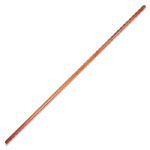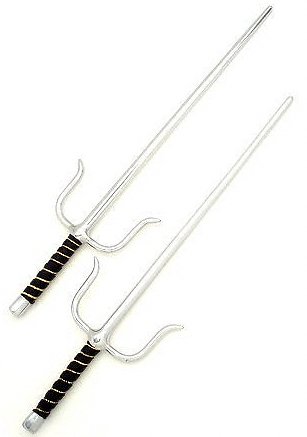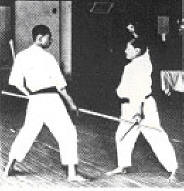The two main weapons practiced in this dojo are:
the Okinawan traditional long range weapon, ' BO ';
 [ Straight styled wooden staff, although their are some kobudo styles that prefer tapered ends. 1-1/4 inches in diameter, made from Hardwood such as Oak, length 5 feet or 6 feet long. ]
[ Straight styled wooden staff, although their are some kobudo styles that prefer tapered ends. 1-1/4 inches in diameter, made from Hardwood such as Oak, length 5 feet or 6 feet long. ]
and the short range weapon, ' SAI '.
 [ Leather or cord wrapped handles. Round or octagonal stems. Each sai weighs approximately 1.4 pounds. Usually carried in pairs, but some Okinanwan practitioners carried three. Sizes 15 inches, 18 inches, or 19-1/2 inches. ]
[ Leather or cord wrapped handles. Round or octagonal stems. Each sai weighs approximately 1.4 pounds. Usually carried in pairs, but some Okinanwan practitioners carried three. Sizes 15 inches, 18 inches, or 19-1/2 inches. ]
Some Karate practitioners have publicly said that ' real ' Karate does not include weapons training, because Karate literally means ' empty hand ', and the introduction of weapons is a plot to enhance student numbers, using Hollywood's version of martial arts.
Also that Gichin Funakoshi, (founder of Shotokan and the reputed 'Father of Modern Karate'), did not include weapons in Karate.

Funakoshi with Sai practicing against opponent with bo.
However well-intentioned those Karate practitioners may have been to show the public ' real ' Karate, they themselves are mis-informed.
Archived photos of Funakoshi prove different, as he was a practitioner of both the bo and the sai.
He simply did not introduce these Okinawan weapons to the Japanese when he was attempting to introduce Shotokan Karate to Japan.
Historically, the original meaning of Karate was ' China hand ', and the Chinese Martial Arts had a plethora of weapons besides the use of hands and feet in Chinese boxing.
There are many books that have been written telling us how historically Okinawan warriors converted farm implements to weapons for battle.
So, to take a quote from those practitioners, ' real ' Karate has always included the use of weapons training.
As for the origins of Shorinjiryu Kenkokan Karate, weapons training was always a part of Karate training as an extension of the hand.
 Leroy Throop Martial Arts Studio
Leroy Throop Martial Arts Studio